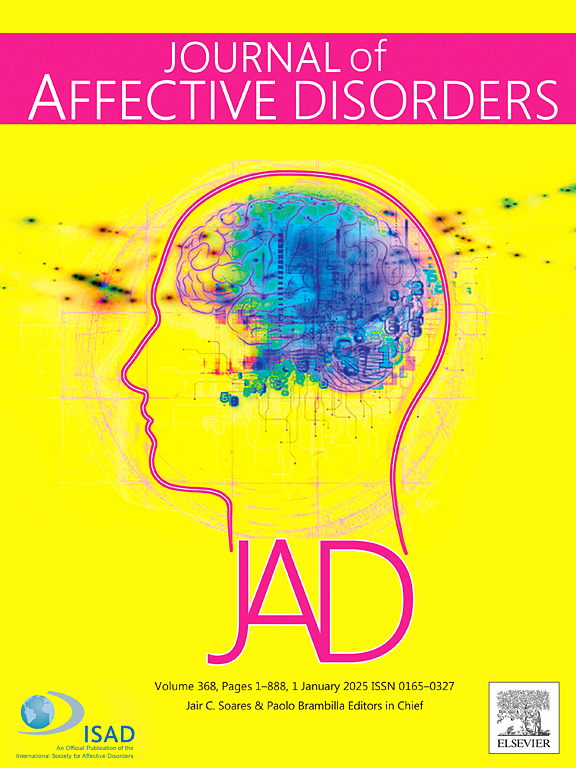Intrinsic functional brain connectivity in adolescent anxiety: Associations with behavioral phenotypes and cross-syndrome network features
IF 4.9
2区 医学
Q1 CLINICAL NEUROLOGY
引用次数: 0
Abstract
Background
Considerable research has mapped the human brain networks implicated in anxiety. Yet, less is known about the intrinsic features of the brain implicated in adolescent anxiety and their generalizability to affective and behavioral problems. To this end, we investigated the intrinsic functional connectomes associated with anxiety, their associations with behavioral phenotypes of clinical interest, and the cross-syndrome overlap between the anxiety network and other affective syndromes in an adolescent sample.
Methods
We used the Boston Adolescent Neuroimaging of Depression and Anxiety (BANDA) dataset which comprises 203 clinical and healthy adolescents aged 14–17. Participants underwent a resting-state magnetic resonance imaging scan and completed the Child Behavior Checklist (CBCL) and Behavioral Inhibition/Activation System scale. Using network-based statistics, we identified functional networks associated with anxiety and other behavioral syndromes. The anxiety network strengths were then correlated with behavioral measures.
Results
A significant resting-state functional network associated with anxiety was identified, largely characterized by hyperconnectivity between the somatomotor and both the default mode network and subcortical regions. Network strengths derived from the anxiety network were significantly correlated to various behavioral syndromes, including internalizing and externalizing tendencies. Cross-syndrome overlapping edges were also observed in networks of internalizing disorders, more prominently post-traumatic stress syndromes.
Conclusions
Our results revealed the functional connectomes characteristic of anxiety in adolescents. This resting-state functional network was also predictive of and shared similar features with behavioral syndromes typically associated with anxiety-related disorders, providing evidence that the high comorbidity of anxiety with other clinical conditions may have a neurobiological basis.
青少年焦虑的内在功能性脑连通性:与行为表型和交叉综合征网络特征的关联。
背景:相当多的研究已经绘制了与焦虑有关的人类大脑网络。然而,关于青少年焦虑的大脑内在特征及其对情感和行为问题的概括性,我们所知甚少。为此,我们研究了与焦虑相关的内在功能连接体,它们与临床感兴趣的行为表型的关联,以及青少年群体中焦虑网络和其他情感综合征之间的交叉综合征重叠。方法:我们使用波士顿青少年抑郁和焦虑神经影像学(BANDA)数据集,该数据集包括203名14-17岁的临床健康青少年。参与者接受静息状态磁共振成像扫描并完成儿童行为检查表(CBCL)和行为抑制/激活系统量表。使用基于网络的统计,我们确定了与焦虑和其他行为综合征相关的功能网络。然后,焦虑网络强度与行为测量相关联。结果:发现了一个与焦虑相关的重要静息状态功能网络,其主要特征是躯体运动神经网络与默认模式网络和皮层下区域之间的超连通性。焦虑网络衍生的网络优势与内化倾向和外化倾向等多种行为综合征显著相关。在内化障碍网络中也观察到交叉综合征重叠边缘,更突出的是创伤后应激综合征。结论:我们的研究结果揭示了青少年焦虑的功能连接体特征。这种静息状态功能网络也可以预测与焦虑相关障碍相关的典型行为综合征,并具有相似的特征,这为焦虑与其他临床状况的高合并症可能具有神经生物学基础提供了证据。
本文章由计算机程序翻译,如有差异,请以英文原文为准。
求助全文
约1分钟内获得全文
求助全文
来源期刊

Journal of affective disorders
医学-精神病学
CiteScore
10.90
自引率
6.10%
发文量
1319
审稿时长
9.3 weeks
期刊介绍:
The Journal of Affective Disorders publishes papers concerned with affective disorders in the widest sense: depression, mania, mood spectrum, emotions and personality, anxiety and stress. It is interdisciplinary and aims to bring together different approaches for a diverse readership. Top quality papers will be accepted dealing with any aspect of affective disorders, including neuroimaging, cognitive neurosciences, genetics, molecular biology, experimental and clinical neurosciences, pharmacology, neuroimmunoendocrinology, intervention and treatment trials.
 求助内容:
求助内容: 应助结果提醒方式:
应助结果提醒方式:


